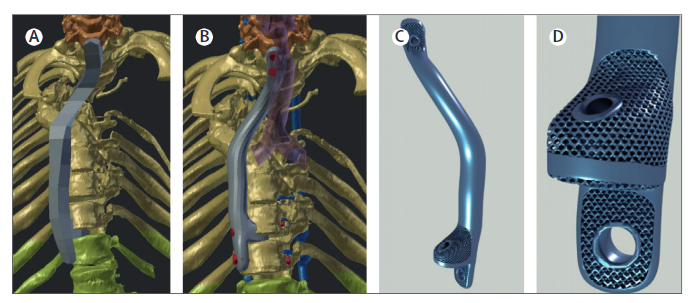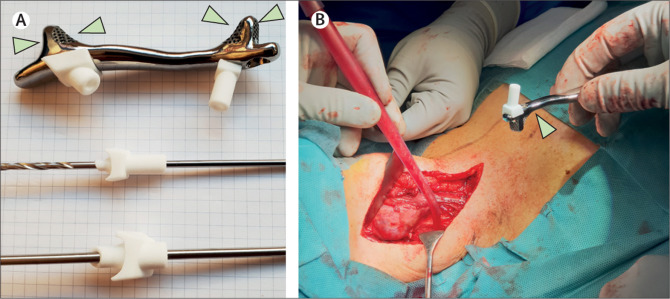In the recently published ‘Challenges in the design and regulatory approval of 3D printed surgical implants: a two-case series,’ authors Koen Willemsen, Razmara Nizak, Herke Jan Noordmans, René M Castelein, Harrie Weinans, and Moyo C Kruyt explore the use of 3D printed implants for treatment of spinal conditions, studying two different cases.
Both patients exhibited ‘semi-urgent’ cases of spinal instability as they were admitted to the researchers’ hospital in the Netherlands:
- Case One – severe kyphotic deformity of the thoracic spine due to neurofibromatosis, causing incomplete paralysis, with a metallic strut used to provide anterior support
- Case Two – progressive paralysis caused by cervicothoracic dissociation due to vanishing bone disease, with an implant spanning the anterior spine inserted
Both cases were considered complex, and traditional techniques ineffective. To overcome previous obstacles, the researchers 3D printed titanium implants created from their CT scans. The customized medical devices were fabricated with direct metal printing and then tested for strength, as well as biocompatibility. The researchers point out that previously, surgeons had been concerned about using 3D printed implants because of restrictive legislative regulations in the Netherlands, but throughout this study, the effectiveness of such patient-specific treatment with successful outcomes was emphasized.
“An exemption from the usual approval procedure for the use of personalized implants can be obtained in an emergency or exceptional-use situation, when specific safety requirements are met. We believe that thorough and efficient interactions between medical engineers and physicians to establish well-designed frameworks to navigate the logistical and regulatory aspects of personalized implant development are necessary,” stated the researchers. “These frame-works can be locally administered and managed to obtain legal clearance for personalized implants in an optimal manner; only then can the possibilities be effectively exploited and the expected increase in personalized solutions accommodated.”
During the study they describe workflow and framework for 3D printing for complex surgeries for the patients, exhibiting ‘severe destruction’ of the spine. Because of the complexities of the spinal conditions, there simply were no standard devices or surgeries available, but the researchers explain that without implants of some sort, the patients were in danger of developing paraplegia. In the meantime, their spines were being protected with the external orthoses.
Case one refers to a 16-year-old boy who had previously been treated for severe dystrophic scoliosis; fusion failed over time, however, and his situation was becoming more dire.
“We concluded that a strong and solid metallic strut would be needed at the anterior side to assure reliable long-term support. Such a prosthesis had to be fixed and would ultimately need to integrate into the proximal and distal viable vertebral bone without interfering with vital structures such as the heart, lungs, and bronchi. The shape of the prothesis had to be customized to ensure a perfect fit,” stated the researchers.
The medical device was allowed for use due to the exceptional details of the case.

(A) The first step in the design process: a prototype that follows the mechanical axis near the spine, attaching to the last mechanically stable vertebrae in the cervical spine (C4–C5) and bridging the unstable part (C6–T11) to the first mechanically stable vertebra distal of the defect (T12). (B) Restructured prototype with the addition of screw holes and their trajectories. (C) Final implant design (rendered picture). (D) Close-up view of the porous mesh structure to allow bone ingrowth, with distal screw holes
Two proximal and distal screw holes were included in the implant for fixation, and in-silico analysis was performed. The implant ‘easily sustained’ axial stress of 500 N, and a biomechanical compression test showed ten times more stiffness and strength than a traditional 5.5 mm titanium rod. The implants were 3D printed using medical grade titanium on a DMP320 3D printer, and implanted six months after the emergency stabilization surgery—which was ‘uneventful and went as planned.’ The surgical procedure took only 150 minutes, and there were no complications. The patient recovered well, went home in a week, and did well, despite a fatigue fracture that had to be repaired in one of the rods.
The second patient was a 68-year-old female who had already received several surgeries, with the vanishing bone disease a condition of ‘unknown cause characterized by the destruction and absorption of bone.’ Due to a trauma, the posterior fixation in place failed and caused her spine to collapse—resulting in neurological problems.
“After approval from the surgical team, the personalized implant and one oversized version (with an additional 3 mm in height) were printed in titanium following the same production method as that for case 1,” stated the researchers.
The implant was inserted six weeks after the stabilization surgery, with no complications. Surgery only took 120 minutes, and the patient did well afterward. After six months, the patient was walking normally again.
“When the primary concern is the health of the patient, the surgeon can take responsibility for decisions that might deviate from the typical regulations, as long as they verify the safety of the treatment approach by providing argumentation and the rationale in the technical file for the implant,” concluded the researchers, who are hopeful that this study will accelerate the use of personalized implants.
3D printed implants are a fascinating subject today, not only because there are so many different types, but because of the ability they have to change a patient’s quality of life, from cochlear implants to titanium implants and even mandibular grafts. What do you think of this news? Let us know your thoughts! Join the discussion of this and other 3D printing topics at 3DPrintBoard.com.
[Source / Images: ‘Challenges in the design and regulatory approval of 3D printed surgical implants: a two-case series’]
Subscribe to Our Email Newsletter
Stay up-to-date on all the latest news from the 3D printing industry and receive information and offers from third party vendors.
You May Also Like
Precision at the Microscale: UK Researchers Advance Medical Devices with BMF’s 3D Printing Tech
University of Nottingham researchers are using Boston Micro Fabrication‘s (BMF) 3D printing technology to develop medical devices that improve compatibility with human tissue. Funded by a UK grant, this project...
3D Printing Webinar and Event Roundup: April 21, 2024
It’s another busy week of webinars and events, starting with Hannover Messe in Germany and continuing with Metalcasting Congress, Chinaplas, TechBlick’s Innovation Festival, and more. Stratasys continues its advanced training...
3D Printing Webinar and Event Roundup: March 17, 2024
It’s another busy week of webinars and events, including SALMED 2024 and AM Forum in Berlin. Stratasys continues its in-person training and is offering two webinars, ASTM is holding a...
3D Printed Micro Antenna is 15% Smaller and 6X Lighter
Horizon Microtechnologies has achieved success in creating a high-frequency D-Band horn antenna through micro 3D printing. However, this achievement did not rely solely on 3D printing; it involved a combination...































